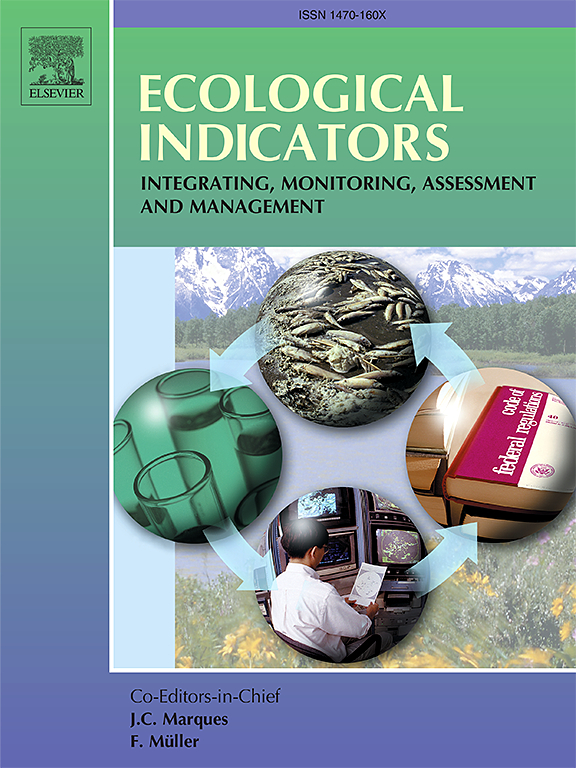Assessing the integrated conservation effectiveness of protected areas on forest ecosystems in the Three Parallel Rivers Region, China
IF 7
2区 环境科学与生态学
Q1 ENVIRONMENTAL SCIENCES
引用次数: 0
Abstract
Protected areas (PAs) are critical for safeguarding biodiversity and maintaining ecosystem services. Assessing the conservation effectiveness of PAs in preserving forest ecosystem is of considerable significance in promoting management and policy recommendations of PAs. However, studies on the integrated effectiveness of PAs in enhancing forest coverage, improving forest ecosystem services, and mitigating forest fragmentation remains relatively limited. In this study, we chose three indicators include fraction vegetation coverage (FVC), forest fragmentation index (FFI), and ecosystem services (ESs, including water retention, soil conservation, carbon sequestration, and habitat quality) to investigate the conservation effectiveness of PAs in preserving forest ecosystems within the Three Parallel Rivers Region (TPRR), China. The results indicated that during the past two decades (2001–2020), 48.81%, 52.11%, and 59.82% of the areas within PAs showed positive or stable trends in FVC, FFI, and ESs, respectively. The integrated assessment revealed mixed results: 33.03% of the area within PAs achieved high conservation effectiveness, while 60.73% showed medium effectiveness. Overall, while 93.76% of the area showed a positive trend in at least one of the three indicators, this highlights the complex trade-offs in conservation outcomes. Moreover, the influencing factors of integrated conservation effectiveness were analyzed using the random forest model, revealing that natural factors and the size of protected areas had the greatest impact. To further enhance overall conservation effectiveness, more stringent management measures should be implemented at the local level nature reserves in this region. This multi-indicator assessment reveals the complexity of forest ecosystems across different regions, which facilitates the incorporation of additional indicators and provides guidance for a more comprehensive evaluation of the conservation effectiveness of diverse natural ecosystems in future research.
三江并流地区森林生态系统保护区综合保护效果评价
保护区对于保护生物多样性和维持生态系统服务至关重要。评估保护区在保护森林生态系统中的保护效果,对促进保护区的管理和提出政策建议具有重要意义。然而,关于保护区在增加森林覆盖、改善森林生态系统服务和缓解森林破碎化方面的综合有效性的研究仍然相对有限。本研究选取植被覆盖度(FVC)、森林破碎化指数(FFI)和生态系统服务功能(ESs,包括保水、保土、固碳和生境质量)3个指标,探讨了三江并流地区森林保护地对森林生态系统的保护效果。结果表明:近20 a(2001—2020年),保护区内植被覆盖度、FFI和ESs分别有48.81%、52.11%和59.82%呈正趋势或稳定趋势;综合评价结果显示,保护区内33.03%的面积达到高保护效果,60.73%的面积达到中等保护效果。总体而言,尽管93.76%的区域在三项指标中至少有一项表现出积极趋势,但这凸显了保护结果的复杂权衡。利用随机森林模型对综合保护效果的影响因素进行了分析,发现自然因素和保护区规模对综合保护效果的影响最大。为了进一步提高整体保护效果,应在该地区的地方一级自然保护区实施更严格的管理措施。这种多指标评价揭示了不同区域森林生态系统的复杂性,有利于纳入其他指标,为今后研究更全面地评价不同自然生态系统的保护效果提供指导。
本文章由计算机程序翻译,如有差异,请以英文原文为准。
求助全文
约1分钟内获得全文
求助全文
来源期刊

Ecological Indicators
环境科学-环境科学
CiteScore
11.80
自引率
8.70%
发文量
1163
审稿时长
78 days
期刊介绍:
The ultimate aim of Ecological Indicators is to integrate the monitoring and assessment of ecological and environmental indicators with management practices. The journal provides a forum for the discussion of the applied scientific development and review of traditional indicator approaches as well as for theoretical, modelling and quantitative applications such as index development. Research into the following areas will be published.
• All aspects of ecological and environmental indicators and indices.
• New indicators, and new approaches and methods for indicator development, testing and use.
• Development and modelling of indices, e.g. application of indicator suites across multiple scales and resources.
• Analysis and research of resource, system- and scale-specific indicators.
• Methods for integration of social and other valuation metrics for the production of scientifically rigorous and politically-relevant assessments using indicator-based monitoring and assessment programs.
• How research indicators can be transformed into direct application for management purposes.
• Broader assessment objectives and methods, e.g. biodiversity, biological integrity, and sustainability, through the use of indicators.
• Resource-specific indicators such as landscape, agroecosystems, forests, wetlands, etc.
 求助内容:
求助内容: 应助结果提醒方式:
应助结果提醒方式:


